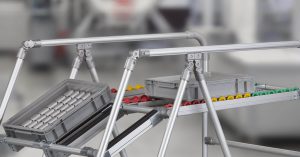Why Kanban is crucial for lean production.
We’re not exaggerating when we describe lean production as a resounding success story. Besides spreading across the world, its influence has extended to areas way beyond industrial production, with lean management being a prime example. The term Kanban is currently on everyone’s lips, particularly in the start-up scene. This is mainly down to the amazing popularity of scrum (including in mechanical engineering), which involves prioritizing tasks and recording progress on Kanban boards. Given how easy it is to forget that Kanban first emerged in lean production, fans of agile project management would do well to take a closer look at Kanban in its original context.
FAQ about the Lean Production Building Kit System
Whether it‘s components, technical details or lean methods: Learn about the benefits of lean production with item in short videos.
GO TO PLAYLISTWhat is Kanban? Etymology & definition
Translated into English as “signboard” or “billboard”, Kanban is a method for managing production sequences in lean production operations. Kanban was invented in 1947 by the lean production pioneer Taiichi Ohno (1912-1990), who was later happy to explain his motivations: “It simply had to be possible to organise the flow of materials in production according to the principles that apply in a supermarket – a consumer picks an item with a certain specification and quantity from the shelf, the gap is noticed and the item is restocked.” In practice, using Kanban in lean production involves recording information about 1) removal, 2) transport and 3) production on Kanban cards. Companies can use this information to order, manufacture and move components and materials exactly as needed.
A Kanban system can be used specifically to prevent overproduction.
If no more components are left at a workstation, the time has come for a new Kanban card. This card sends a new order to the production station upstream, which responds by carrying out the order. The information on a Kanban card either represents a transport order (transport Kanban, e.g. from the warehouse), or a production order (production Kanban). In any event, companies using Kanban in lean production operations don’t have to go to the extra trouble of planning production. A Kanban system can also be used specifically to prevent overproduction (one of the 7 Muda). Although it will not completely eradicate buffers and stock-keeping, the subsequent removal of Kanban and focussed improvement enable companies to continuously reduce stock levels. Passing on faulty products is prohibited, as doing so can lead to bottlenecks. Nonetheless, Kanban isn’t a sure-fire way to rule out production errors. This calls for other measures such as Poka Yoke to be implemented.
Lean production – Kanban, the pull principle and one-piece flow
Kanban can be used to achieve what’s known in lean production as the pull principle. The most important feature of pull systems is the upper limit on stock levels. Besides Kanban, such systems include the FIFO principle, one-piece flow, CONWIP (constant work in process) and POLCA (paired-cell overlapping loops of cards with authorization). The actual consumption at the different stations of the production process is what regulates material supply. At the heart of it, the pull principle involves a customer order indicating a demand – a signal that is passed on to the production step upstream. This creates a chain that extends to the material supply for the very first work step.
Kanban has actually achieved its aim when it ‘eradicates itself’.
All the same, Kanban isn’t the be-all and end-all. By putting it in place, you’re only halfway towards establishing lean production. This ties in with Kanban’s actual aim, which can only be fully achieved when Kanban “eradicates itself”. In other words, stock levels in production are continuously reduced, creating a better flow with shorter throughput times. Let’s quickly run through a real-life scenario from lean production. Imagine cards are being removed one by one from a functioning system of circulation – until problems surface. The relevant obstacles are then dealt with, which is a perfect expression of the continuous improvement process. In the end, no more cards are left to start a production flow. As Kanban represents stock, this means there are no longer any stocked materials or buffers between the processes. Bit by bit, you have achieved a one-piece flow, in which a part is passed on as soon as it has been processed rather than stock being stored between the work stages.
Kanban isn’t always the best solution
There are some situations where Kanban is not appropriate. Companies can conduct an ABC-XYZ analysis to find out what components Kanban would work well with. In most cases, these are components that are in steady demand in large quantities. Under the terms of this analysis, it is the AX, AY and BX components that are particularly suitable for Kanban. With that in mind, Kanban is usually best suited to ‘runners’ and series production. By contrast, Kanban often can’t be implemented in the production of one-off articles, small series or customer-specific products. However, companies can still adopt different methods, such as CONWIP or POLCA, to benefit from the advantages that pull systems offer.
Are you interested in fascinating reports and innovations from the world of lean production? Then we have just what you’re looking for! Simply subscribe to the item blog by completing the box at the top right!






